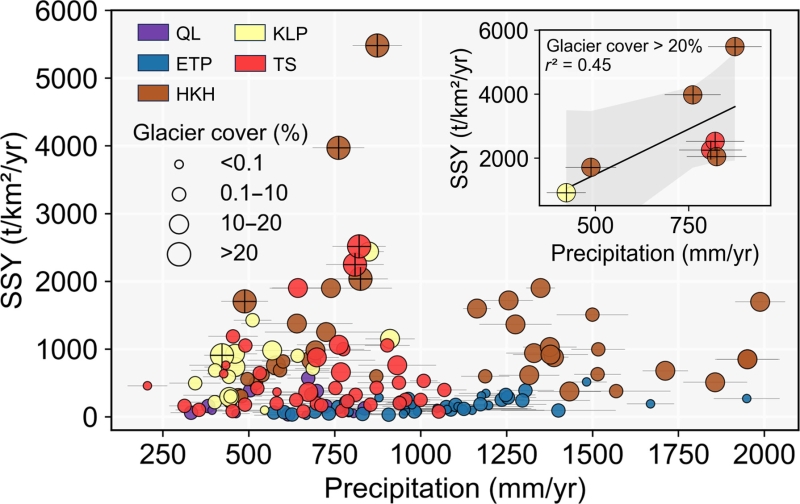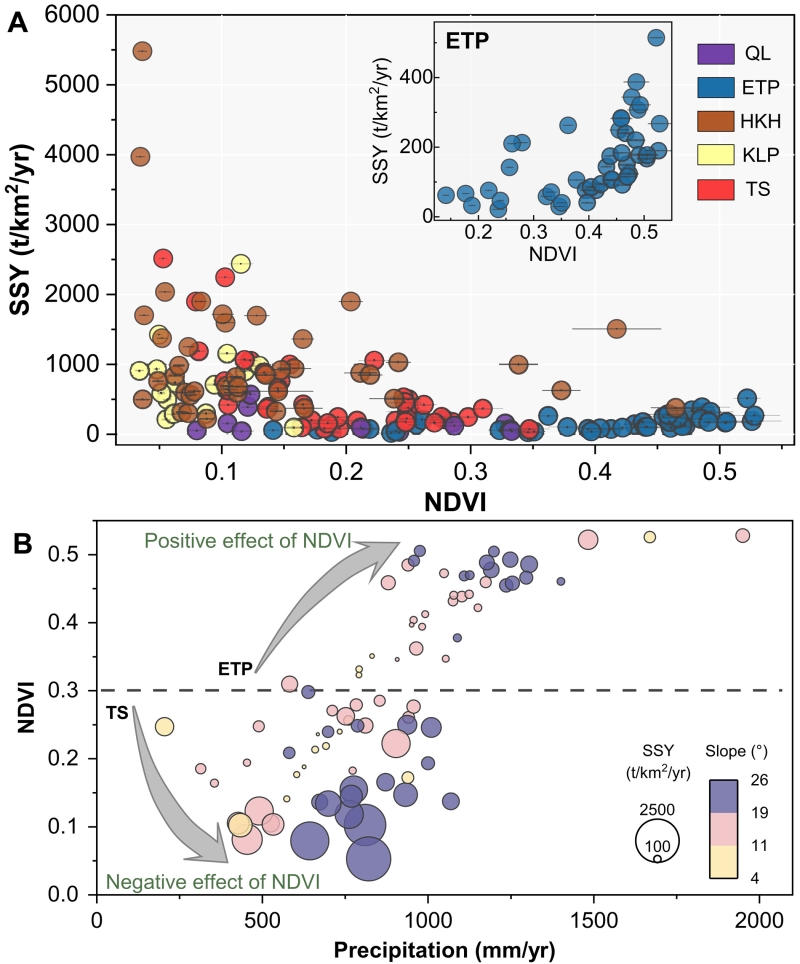Abstract: Investigating
erosion and river sediment yield in high-mountain areas is crucial for
understanding landscape and biogeochemical responses to environmental change.
We compile data on contemporary fluvial suspended sediment yield (SSY) and 12
environmental proxies from 151 rivers in High Mountain Asia surrounding the
Tibetan Plateau. We demonstrate that glaciers exert a first-order control on
fluvial SSYs, with high precipitation nonlinearly amplifying their role,
especially in high–glacier cover basins. We find a bidirectional response to
vegetation’s influence on SSY in the Eastern Tibetan Plateau and Tien Shan and
identify that the two interacting factors of precipitation and vegetation cover
explain 54% of the variability in SSY, reflecting the divergent roles of
vegetation in promoting biogenic-weathering versus slope stabilization across
bioclimatic zones. The competing interactions between glaciers, ecosystems, and
climate in delivering suspended sediment have important implications for
predicting carbon and nutrient exports and water quality in response to future
climate change.
Many
high-mountain rivers in Asia transport more sediment downstream compared to a
few years ago. Changes in sediment levels have a particularly strong impact on
agriculture, water quality, flood management, and hydropower generation. A
study with participation of the University of Potsdam demonstrates the
interacting roles of glaciers, vegetation, precipitation, and slope in
mobilizing sediment and controlling the current sediment transport in rivers.
In
order to counteract climate change, the authors call for a systematic approach
for the entire catchment area of rivers in the high mountains.
"The
specific sediment yield in catchments with high glacial cover is on average an order
of magnitude higher than glacier-free basins, and appears overall higher in
Asia's glacierized catchments than those reported for the European Alps, the
Andes, or Norway," says Bodo Bookhagen, professor for Geological Remote
Sensing at the University of Potsdam.
The
fluvial suspended sediment threatens the water quality downstream and thus the
aquatic ecosystems, the river infrastructure such as hydropower plants and
bridges as well as agriculture and pastoralism.
The
team investigated 151 rivers around the Tibetan plateau and demonstrated that
glaciers exert a first-order control on fluvial sediment yield, especially with
high precipitation and in high glacier-cover basins.
"Our
work highlights the many competing factors in controlling the transported
material in river catchments and shows that a more accurate prediction of the
sediment volume should consider not only climate change, but also glacier
dynamics and vegetation changes and their interactions with slope," Bodo
Bookhagen emphasizes.
Vegetation influences sediment transport especially in the Eastern
Tibetan Plateau and Tien Shan. Depending on climate zone, vegetation can either
promote erosion of material or have a stabilizing effect on slopes. These
findings call for a systematic basin-wide approach to climate change adaptation
in high mountain regions.

The observed relationship between SSY and
mean annual precipitation conditioned by glacier cover (circle sizes)

The observed relationship between SSY and
vegetation cover (NDVI) and precipitation
Source: Dongfeng Li, Ting Zhang, Desmond E. Walling, Stuart Lane,
Bodo Bookhagen, Shang Tian, Irina Overeem, Jaia Syvitski, Albert J. Kettner,
Edward Park, Michèle Koppes, Rafael J. P. Schmitt, Weiling Sun, Jinren Ni, Todd
A. Ehlers. The competing controls of glaciers, precipitation, and vegetation on
high-mountain fluvial sediment yields. Science Advances, 2024; 10 (48) DOI: 10.1126/sciadv.ads6196
University of Potsdam. "Swelling streams -- climate change
causes more sediment in high-mountain rivers." ScienceDaily. ScienceDaily,
4 December 2024. https://www.sciencedaily.com/releases/2024/12/241204114321.htm

